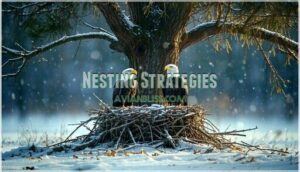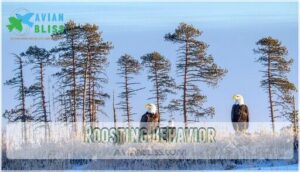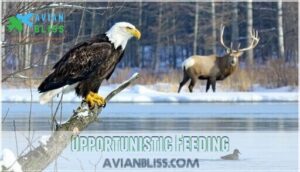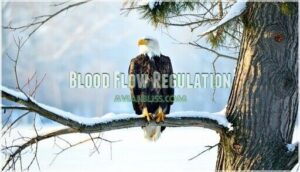This site is supported by our readers. We may earn a commission, at no cost to you, if you purchase through links.
 You’ll be amazed at how cold bald eagles can survive – these incredible birds can handle temperatures as low as -30°F (-34°C) without breaking a sweat.
You’ll be amazed at how cold bald eagles can survive – these incredible birds can handle temperatures as low as -30°F (-34°C) without breaking a sweat.
Their secret weapon? A double-layer feather system that works like nature’s best winter coat. You’ve got fluffy down feathers next to their skin for insulation, topped with waterproof outer feathers that shed snow and ice.
Their feet and beaks have special blood flow patterns that prevent frostbite, while their large body size helps retain heat. During brutal cold snaps, they’ll huddle together in protected roosts and share body warmth.
What’s truly fascinating is how they’ve mastered the art of energy conservation during winter’s harshest months, using techniques like huddling to survive the extreme cold, and their unique physiology to prevent frostbite, all thanks to their large body size and special blood flow patterns, making them a great example of nature’s best winter coat.
Table Of Contents
- Key Takeaways
- How Cold Can Bald Eagles Survive?
- Temperature Tolerance
- Physical Adaptations
- Nesting Strategies
- Migration Patterns
- Roosting Behavior
- Winter Diet
- Blood Flow Regulation
- Information Sharing
- Population Trends
- Conservation Efforts
- Frequently Asked Questions (FAQs)
- How do bald eagles survive in cold climates?
- Do bald eagles live in winter?
- How does temperature affect bald eagles?
- How hot does a bald eagle get?
- Do bald eagles eat cold?
- Can eagles survive winter?
- Can bald eagles survive cold weather?
- How do bald eagles keep their eaglets warm?
- What is the most common cause of death for bald eagles?
- How cold can a bald eagle survive?
- Conclusion
Key Takeaways
- You’ll be amazed that bald eagles can survive temperatures as low as -40°F (-40°C) thanks to their double-layer feather system that traps warm air like nature’s best winter coat.
- Your eagles use specialized blood flow regulation called countercurrent heat exchange – they literally squeeze shut blood vessels in their extremities to prevent heat loss while keeping their core organs warm.
- You’ll find these smart birds conserve energy through strategic behaviors like communal roosting, huddling together for shared body warmth, and entering temporary torpor to lower their metabolic rate during harsh conditions.
- You can count on eagles’ opportunistic winter survival strategy – they’ll switch from fish to roadkill, scavenge carrion, and share information about food sources through their roosting communities.
How Cold Can Bald Eagles Survive?
Ever wonder how these magnificent birds handle winter’s brutal bite?
Bald eagles possess remarkable cold acclimation abilities, surviving temperatures plummeting to -40°F (-40°C).
Nature’s ultimate cold warrior: these feathered survivors master Arctic conditions that would defeat most wildlife.
Their bald eagle cold tolerance stems from incredible adaptations that’d make any winter warrior jealous.
These feathered survivors build up substantial fat reserves during fall migration, creating nature’s own energy bank account.
When temperatures drop, they rely on shivering thermogenesis to generate heat through rapid muscle contractions.
Their eagle temperature range flexibility allows them to lower body temperature slightly, conserving precious energy during harsh conditions.
You’ll find eagles mastering ice fishing, breaking through frozen surfaces with surprising skill.
Their winter tenacity shows through opportunistic feeding strategies and smart roosting choices.
These freezing temperatures eagles endure showcase nature’s engineering at its finest.
Their eagle survival strategies combine physical adaptations with behavioral brilliance, proving these birds are true cold-weather champions built for winter’s toughest challenges.
Temperature Tolerance
How tough are these magnificent birds when winter hits? Bald eagles showcase remarkable cold hardiness that’ll surprise you. Their temperature tolerance lets them thrive in conditions that would challenge most wildlife.
These raptors maintain active lives at temperatures plummeting to -35°C (-31°F) in northern habitats.
Their arctic survival skills kick in through several key adaptations:
- Metabolic acclimation increases energy production below -10°C (14°F)
- Freezing resistance prevents tissue damage during extended cold exposure
- Core body temperature stays at 40°C (104°F) even when air drops below -20°C (-4°F)
- Thermal limits extend to wind chill factors reaching -40°C (-40°F)
- No documented frostbite cases under typical North American winter conditions
Their bald eagle cold tolerance comes from thick plumage and strategic fat reserves. When temperatures drop, these birds don’t just survive—they adapt.
Their eagle temperature range proves nature’s incredible engineering, allowing them to hunt and nest successfully in freezing temperatures eagles would seem unable to handle.
Physical Adaptations
You’ll be amazed at how bald eagles transform into living winter fortresses through their incredible physical adaptations.
These remarkable birds can survive temperatures as low as -40°F thanks to their specialized feather systems and smart blood circulation tricks.
Feather Structure
You’ll find that bald eagles rely on sophisticated feather layers to survive freezing temperatures.
Their feather structure includes outer vanes with barb interlocking systems that trap air, creating natural insulation.
Down feathers underneath provide essential warmth through down density that traps body heat.
Dense feather distribution across their bodies, combined with water resistance and seasonal molting season renewal, creates feather insulation that’s remarkably effective against harsh winter conditions.
Thermal Regulation
After exploring feather insulation, let’s look at how bald eagles keep their engines running in the cold.
Thermal regulation is their secret weapon, letting them outsmart winter’s chill.
Here’s how they do it:
- Blood Flow Regulation: Eagles reduce blood flow to their legs and feet, cutting Heat Loss and keeping their core warm.
- Body Temperature Control: They can slightly lower their eagle body temperature, saving energy when things get icy.
- Metabolic Rate Boost: Eagles ramp up their Metabolic Rate, burning more calories to generate heat.
- Energy Conservation: By limiting movement and finding shelter, they conserve energy, making every bit of warmth count.
Nesting Strategies
You’ll notice bald eagles don’t just pick any old tree for their nests—they choose sheltered sites that block wind and keep out the worst of the cold.
When winter hits hard, they huddle together and fluff up their feathers, turning their nests into cozy, well-insulated shelters.
Sheltered Sites
When you’re looking at bald eagles in winter, you’ll notice they’re picky about their sheltered sites.
These smart birds choose locations with natural wind protection, like dense tree canopies or cliff faces that block harsh gusts.
Nest orientation matters too – eagles often face their nests away from prevailing winter winds. The site microclimate plays a huge role in survival, with eagles selecting spots that stay several degrees warmer than surrounding areas.
Tree species selection is strategic; conifers provide better year-round shelter than deciduous trees. Limited sun exposure during short winter days makes south-facing locations valuable.
These carefully chosen sheltered sites work with their feather insulation system, creating the perfect setup for energy conservation during brutal cold snaps.
Bald eagles build platform nests, but other birds use different strategies, such as cavity nests, to protect themselves.
Huddling Behavior
When temperatures plummet, you’ll spot bald eagles practicing huddling behavior through group roosting.
These magnificent birds cluster side-by-side on branches, creating communal warmth through heat sharing.
This social thermoregulation strategy provides significant huddling benefits, allowing eagles to conserve precious energy.
Roosting in groups represents one of nature’s smartest social behaviors, as shared body heat helps them survive brutal winter nights together.
For supplemental warmth, some bird owners utilize a heated perch option.
Migration Patterns
You might wonder why some eagles stay put while others fly south when winter arrives.
Two main factors drive bald eagle migration patterns: food scarcity forces them to search for open water and available prey, while site fidelity draws many back to their birthplace regardless of harsh conditions.
Food Scarcity
When winter tightens its grip, you’ll witness bald eagles transforming into resourceful survivors. Food scarcity drives these magnificent birds to adapt their hunting strategies and dietary flexibility like seasoned opportunists.
During harsh months, eagles employ three key survival tactics:
- Winter scavenging becomes their lifeline, targeting roadkill and trapped animals along highways
- Alternative prey hunting expands beyond fish to include small mammals and waterfowl
- Opportunistic feeding at fish hatcheries and ice fishing spots where food remains accessible
Their exceptional hunting strategies shine even in icy conditions. You’ll see eagles break through frozen lake surfaces with powerful talons, demonstrating remarkable dietary flexibility that keeps them fed when traditional food sources disappear. Bald eagles are North American birds of prey.
Site Fidelity
When food gets scarce, bald eagles rely on site fidelity—a deep-rooted urge to return to familiar surroundings year after year.
This Return Migration isn’t just about nostalgia; it boosts breeding success and helps with territory defense.
Even if their old nest is gone, they’ll build nearby, showing loyalty to their home turf, and nest reuse plays a big role in eagle winter survival and cold weather survival.
Roosting Behavior
When you’re watching eagles in winter, you’ll notice they don’t just randomly pick any old tree to spend the night.
These smart birds choose roosting spots like clusters of tall white pines that face east, giving them wind protection and easy access to hunting grounds the next morning, which is a smart decision.
Roost Site Characteristics
Beyond migration patterns lies another fascinating aspect of eagle survival: their roost site characteristics.
These magnificent birds aren’t picky about their overnight accommodations—they’re strategic.
Wind Protection keeps eagles warm by choosing sheltered sites protected by vegetation or terrain.
Food Proximity guarantees they’re within 2,250 meters of ice-free water sources.
Tree Species matter too, with white pines being favorites for their sturdy branches and eastern exposure.
Bald eagles require undisturbed wintering habitats to conserve energy.
Here’s what makes perfect roosting behavior spots:
- Mature forests with slopes up to 55 degrees offering natural windbreaks
- Tall trees (16-66 yards high) with 12-39 inch diameters for stability
- Eastern-facing locations catching morning sunlight for warmth
Group roosting in these sheltered sites reduces energy stress during harsh winters.
Energy Conservation
Energy conservation becomes even more sophisticated when you look at the physiological changes eagles make during harsh winters.
These remarkable birds employ several internal mechanisms to maintain their energy reserves while staying warm.
When temperatures drop dangerously low, bald eagles can enter torpor, temporarily lowering their metabolic rate and body temperature to conserve precious calories.
This adaptation allows them to survive extended periods without food while maintaining essential bodily functions.
Their shivering efficiency also plays a key role in thermal regulation.
Eagles generate metabolic heat through controlled muscle contractions, burning through their accumulated fat reserves when needed.
These fat reserves, built up during fall migration, provide essential backup energy during winter fasting periods.
Blood flow regulation works hand-in-hand with feather insulation to minimize heat loss.
Eagles redirect warm blood away from extremities to protect core organs, while their dense plumage traps air for maximum insulation.
During extreme weather, eagles reduce their activity levels substantially, conserving energy by limiting unnecessary movement.
This calorie processing strategy helps them stretch their energy reserves until conditions improve or food becomes available again.
Winter Diet
You’ll notice bald eagles don’t stick to just one menu in winter—they eat whatever they can find, from fish to roadkill.
Their winter diet is all about survival, using scavenging and opportunistic feeding to keep their energy up when the cold sets in, which involves scavenging.
Scavenging Behavior
Resourcefulness drives eagle scavenging tactics during harsh winter months.
You’ll find these majestic birds adapting their winter foraging strategies when traditional food sources become scarce:
- Roadkill consumption – Eagles patrol highways for deer and small mammals
- Carrion feeding – They locate farm animal remains and natural carcasses
- Fish scavenging – Dead fish from ice fishing spots provide easy meals
- Open water hunting – Unfrozen areas attract desperate prey and carrion
Eagles utilize specialized scavenging gear to enhance their foraging capabilities.
Opportunistic Feeding
When winter hits hard, bald eagles don’t stick to a picky menu. They’re masters of opportunistic feeding, switching gears with their winter diet.
You’ll spot them using clever foraging strategies—snatching roadkill, raiding farm remains, or practicing exceptional scavenging tactics. Fish hunting doesn’t stop, especially near open water or fish hatcheries.
Carrion feeding is common, too. This bird’s cold weather behavior is all about prey adaptation, making sure eagle feeding winter habits keep them fueled, no matter how tough things get.
Bald eagles also benefit from consuming high energy foods to sustain themselves during harsh winter conditions, which is a key part of their winter diet and helps with cold weather behavior and overall survival.
Blood Flow Regulation
When temperatures plummet, you’d be amazed at how bald eagles master blood flow control through a process called vasoconstriction. These remarkable birds literally squeeze shut blood vessels in their legs and feet, dramatically reducing heat loss from their extremities.
Bald eagles squeeze shut blood vessels in their legs, cutting heat loss and braving winter’s chill like true survivors.
Here’s where it gets really clever: eagles use countercurrent heat exchange in their legs. Their arteries and veins run side by side, creating a natural thermal exchange system. Cold blood returning from their feet steals warmth from outgoing arterial blood, preheating it before it reaches their core organs.
This sophisticated blood circulation system works like a built-in radiator. Outgoing blood cools to just above freezing—cold enough to minimize heat loss but warm enough to prevent frostbite. Meanwhile, returning blood gets warmed well above freezing, protecting their essential organs from dangerous cooling.
Eagles also have unique breathing mechanisms that help them survive in cold climates.
At night, eagles even lower their metabolic rate and body temperature slightly. This thermal regulation strategy reduces the temperature difference between their body and the frigid environment, helping them burn fewer precious calories while staying alive.
Information Sharing
Collaborative community-networks form the backbone of bald eagles’ winter survival strategy.
You’ll find these cold weather birds gathering at overnight sites, typically clusters of tall trees facing east for ideal morning warmth.
These roosting habits create natural information sharing hubs where eagles observe and learn from one another.
Citizen Science projects and Collaborative Studies reveal how early-rising eagles become scouts, leading others to productive feeding areas.
Through Research Dissemination and Data Accessibility, scientists understand this bird behavior better.
When one eagle discovers roadkill or open water, others quickly follow—it’s nature’s version of social media.
Public Awareness campaigns highlight how this information sharing enhances winter survival rates.
Eagles don’t just survive individually; they thrive collectively, sharing knowledge about food sources and safe roosting spots throughout harsh winter months.
Population Trends
You’ll find bald eagle populations steadily climbing across North America, with mid-winter surveys showing remarkable increases over the past two decades.
New Hampshire’s winter eagle count jumped from fewer than 10 birds in the 1980s to nearly 100 today, proving these cold-weather champions aren’t just surviving harsh winters—they’re thriving.
Increasing Numbers
If you’ve spotted more bald eagles lately, you’re not imagining things.
Thanks to accurate surveys and keen data interpretation, it’s clear that bald eagle numbers have soared—up fourfold since 2009.
Regional variations in population increase show cold weather birds are thriving, and eagle health in winter is strong, thanks to ongoing conservation.
Future projections look bright for these resilient raptors.
Environmental Conditions
You’ll see their remarkable recovery coincides with improving Arctic habitats and climate conditions.
Environmental changes directly affect bald eagles’ survival in cold climates:
- Water availability increases as ice-free zones expand during freezing temperatures
- Weather patterns shift, creating more predictable snowstorms and extreme cold periods
- Habitat loss decreases through conservation efforts protecting nesting areas
These environmental improvements help eagles thrive despite harsh winters.
Conservation Efforts
Conservation efforts have transformed bald eagle survival rates during harsh winters, creating healthier populations that can better withstand extreme cold.
You’ll find that protected habitats and restored ecosystems now support eagles through temperature drops to -40°F, giving these remarkable birds the resources they need to thrive year-round.
Impact on Survival
Conservation efforts have dramatically boosted bald eagle survival rates during harsh winters.
You’ll find that protected habitats give eagles reliable shelter from cold exposure and reduce energy expenditure searching for suitable roosting sites.
Habitat loss prevention guarantees eagles can access food sources year-round, preventing hypothermia and starvation.
These programs also shield eagles from predation risks by maintaining safe nesting areas away from human disturbance.
Wetland conservation also plays a role in protecting waterbird species.
Here’s how conservation directly impacts eagle health winter survival:
- Protected roosting sites reduce cold exposure and lower metabolic stress
- Habitat restoration maintains food availability during severe weather events
- Research programs identify winter survival tactics that inform protection strategies
- Climate change adaptation helps eagles adjust to shifting weather patterns
Ecosystem Health
Through successful wildlife conservation efforts, you’ll witness a remarkable domino effect on ecosystem health.
As bald eagle populations soar, their presence signals thriving biodiversity and improved habitat quality across North America’s waterways.
| Conservation Impact | Ecosystem Indicator | Result |
|---|---|---|
| Prey Abundance | Fish population recovery | Stable food webs |
| Water Purity | Reduced contamination | Healthier aquatic systems |
| Habitat Quality | Protected nesting areas | Species resilience growth |
| Biodiversity Impact | Increased wildlife variety | Ecological balance restored |
This conservation biology success story demonstrates how protecting apex predators creates ripple effects throughout entire ecosystems, enhancing climate change adaptation strategies.
Frequently Asked Questions (FAQs)
How do bald eagles survive in cold climates?
Bald eagles survive freezing temperatures through layered feather insulation, trapping warm air close to their bodies.
They huddle together for shared warmth and use counter-current blood circulation to prevent heat loss from extremities.
Do bald eagles live in winter?
While most birds head south, you’ll find these hardy raptors weathering brutal winters right where they are.
Eagles don’t just survive cold—they thrive, using specialized feathers and smart behaviors to endure temperatures down to -40°F, and they truly thrive in these conditions.
How does temperature affect bald eagles?
Temperature affects you as a bald eagle through your remarkable adaptations.
You’ll maintain normal body temperature even at -40°F using layered feathers that trap air.
Your blood circulation redirects warmth from extremities to essential organs during freezing conditions, which is a crucial aspect of your overall temperature regulation.
How hot does a bald eagle get?
Despite temperatures reaching 104°F (40°C), you’ll find eagles staying surprisingly cool through specialized blood vessels in their legs and feet that regulate heat.
Their thermal comfort zone spans 23°F to 77°F, keeping them balanced year-round.
Do bald eagles eat cold?
You’ll find that eagles don’t actually "eat cold" – they consume fish, small mammals, and carrion regardless of temperature. Their prey’s temperature doesn’t affect their feeding behavior or digestion.
Can eagles survive winter?
Amazingly, you’ll spot eagles thriving through harsh winters when temperatures plummet to -40°F.
Their layered feathers create incredible insulation, while specialized blood circulation and communal roosting help them survive freezing conditions successfully.
Can bald eagles survive cold weather?
Bald eagles handle frigid temperatures remarkably well.
You’ll find they survive down to -40°F thanks to specialized feathers that trap warm air and smart blood circulation that keeps their core organs toasty.
How do bald eagles keep their eaglets warm?
When push comes to shove, you’ll see eagle parents use their own bodies like a heated blanket, spreading wings and fluffing feathers to cover eaglets.
They block wind, trap warmth, and even tuck chicks underneath for extra insulation.
What is the most common cause of death for bald eagles?
You’ll find trauma and lead poisoning are the top killers . Car accidents and eating contaminated prey from hunters’ lead bullets devastate eagle populations nationwide.
How cold can a bald eagle survive?
Eagles can survive temperatures as low as -40°F (-40°C) thanks to their incredible feather insulation system.
You’ll find they use dense down feathers and specialized blood circulation to maintain their 104°F body temperature even during harsh Arctic conditions, which is made possible by their incredible adaptation mechanisms.
Conclusion
Studies show that bald eagles can survive temperatures as low as -30°F for extended periods without significant mortality.
Understanding how cold bald eagles can survive reveals nature’s remarkable engineering.
You’ve learned these magnificent birds use double-layer feathers, specialized blood circulation, and behavioral adaptations like communal roosting.
Their large size helps retain heat while waterproof plumage prevents ice buildup.
Through energy conservation and strategic shelter selection, bald eagles thrive in harsh winter conditions that would challenge many species.
















